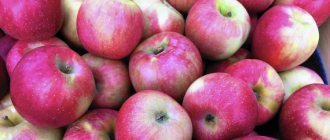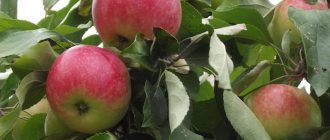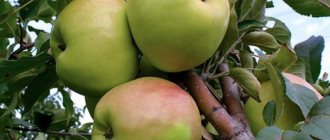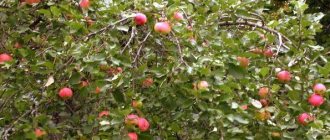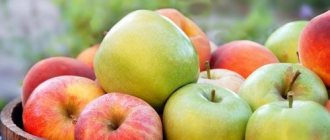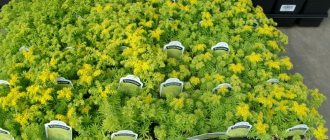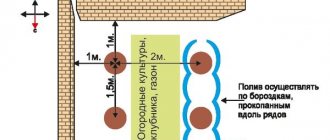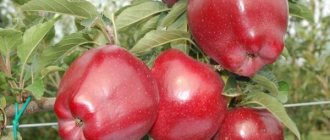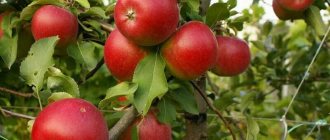Summer varieties of apple trees
Summer apple varieties begin to ripen in July. They are not suitable for long-term storage, but they can be eaten immediately and used for processing.
Quinty
The Canadian summer variety is resistant to drought and heat, but does not tolerate frost. Sweet and sour aromatic apples ripen very early, earlier than most other varieties.
Summer striped
The variety got its name for the characteristic striped blush on the greenish fruits. These tender-fleshed apples are good fresh and for processing.
Mantet
The tasty early variety is very productive. The white flesh is very tender, and the yellowish skin turns orange and red as it ripens.
Candy
The domestic variety ripens quickly and produces beautiful yellow fruits with red stripes. Apples are very sweet, but do not store well, so they should be consumed within two weeks.
Red early
Here the name of the variety speaks for itself again - and the fruits ripen by the end of July. They keep well for a month, are very soft and tasty, but quickly crumble when ripe.
We tell you how to recognize the variety of apple tree by external signs
A summer resident, having visited the market of farmers or seedling producers, will be amazed by the variety of varieties of apple trees, and they all have tasty fruits in their own way.
However, this will only be a small sampling of the more than 7,500 varieties grown around the world. And sometimes it is very difficult to determine by appearance what kind of apple tree is in front of you.
Often it is simply impossible to tell by the appearance of the apple what kind of apple is in front of you - there will be too many options that are similar to each other.
But often the task is to make sure before buying a seedling that they are selling you exactly the variety that the seller claims it to be.
This task is already easier to solve.
You will need to find and print out a description and photo of the variety you need in advance (from a reliable source), and when purchasing, carefully check the appearance of the proposed seedling.
Often, just by the color of the bark, the shape of the leaves, the angle of inclination of the branches from the central trunk and other signs, you can see that the seedling somehow does not correspond to the description from the register of varieties, and then you should refrain from purchasing. These signs will be discussed in this article.
How can you determine by looking at the tree what type of apple tree you are holding? Varieties are determined by the following characteristics:
- Bark color;
- By skin color, fruit size;
- The size of apples;
- The aroma and firmness of apples;
- The shape of the crown and leaf blade and many other parameters.
So how can you find out what kind of variety the buyer is looking at?
How to recognize an apple tree variety by various characteristics
Of all the variety of apple trees, there are those that are easiest to recognize. They have clearly defined distinctive features, which allows them to be quickly identified.
Read about which varieties of apple trees are best to plant in your dacha here.
For example, one cannot help but recognize the common Antonovka apple tree, because... apples with such a fragrant bouquet are characteristic only of this variety. But what to do if the mother tree is far away, and in front of the buyer there is only a plate with “advertising” fruits and bunches of seedlings. It's more difficult here.
After all, the identification of varietal characteristics in a seedling requires the study of all the main morphological characteristics of each variety. And there are many of them, and this is a real problem for a simple gardener.
And first, it’s worth finding out the color of the young bark and the shape of the leaves that the proposed variety has, and then the period of ripening of the fruits until they are ripe.
And at the very end, look at the color, shape and other characteristics of the fruit itself.
IMPORTANT! Find out in advance all the varietal characteristics of the apple tree using pomology, and only then look for its seedlings to check whether the seedling matches the description before purchasing!
Along the tree crown
Already in a young seedling, it is noticeable what the specificity of branching is and how the crown of the tree will be formed in the future.
For example, sharp angles between the branch and the trunk, and the branching itself, similar to a pyramid, are a serious sign in determining the grade.
Thus, the Ural Bulk variety is characterized by almost drooping branches.
Ural bulk apple.
By external signs of the seedling?
In this article you will learn how to grow an apple tree seedling.
The shape of the seedling crown is:
- Reverse pyramidal;
- Pyramidal;
- Globular;
- Round-ovoid;
- Spreading.
Crown shape.
Varieties also differ in the formation of branches of the next order and the type of branching itself (strong, weak). Branches and twigs can be thin or thick.
CAREFULLY! When choosing seedlings, carefully inspect them so as not to introduce dangerous pests or diseases into the area.
According to ripening time
According to the period of fruit formation, apple varieties are divided into:
And according to their shelf life, there are short-life and long-term, and if for “summer apples” the maximum shelf life is 21 days, then long-term “winter apples” can be stored for almost 9 months!
By seed
The seeds in an apple are:
- Tightly covered with seed pads;
- Half open;
- Fully open.
Apple seeds themselves are divided into small, medium and large. And their color varies into light and dark tones of brown or grayish-chestnut. They are in form:
- Flat and plump;
- Long and short.
In this section you can read how to grow an apple tree from a seed.
By bark color
Another sign of the variety is the color of the young bark, which appears on branches of last year’s growth. It happens:
- Grayish-herbal;
- Brownish-mousy;
- Dark gray;
- Light coffee;
- Yellow chocolate;
- Reddish chestnut;
- Brown.
For example, the ancient variety of apple trees from the EU “Ebony” is so named for the black-brown color of the bark of most twigs and branches.
By the leaves
The most important indicator of each variety is its leaves. They may differ in size, configuration, color and convexity along the central leaf vein.
The leaf sizes are:
- Large;
- Medium size;
- Small ones.
By configuration:
- Oblong;
- Ellipsoidal;
- Ovoid;
- Obovate;
- Almost round.
Along the edge of the sheet
Another important feature for determining the variety is the edge of the leaf blade, which can be:
- Crenate (lobes of the jagged edge are large or small, but always rounded);
- Serrated (sharp lobes).
But occasionally serrated and double-canceled ones are found.
FOR YOUR INFORMATION! White filling has leaves with a serrated edge, while Papirovka has leaves with a crenate leaf edge.
By color (during flowering)
Only a professional can determine the variety based on the flowers themselves (their shade and shape of the petals). But by the time of flowering of apple trees it is already easier to determine what type of variety it is.
Only a professional can determine the variety based on the shape of the flower.
After all, apple trees bloom from 8 days to two weeks, and these periods are constant for each specific variety. Only during a sharp cold snap or chilly weather does flowering last for two decades.
Attention! Sometimes the color of the petals can change due to fertilizing with microelements, so this is an unreliable sign of quality!
According to the shape of the fruit
Also, the appearance of the apple itself is used as a sign of identifying the variety. This is one of the most popular questions on our website - “Help me identify the variety from a photo of an apple.”
How to recognize the variety of apple tree by apple? To conduct the study, typical fruits are taken from the tree under study (those that are most often found on the apple tree under study) and which are well illuminated by the sun.
In order to determine the variety of apple tree by fruit, they are first classified by size. They are divided into:
- Very large;
- Large;
- Large;
- Average;
- Below average;
- Small;
- Tiny (berry forms of apple trees).
According to the shape of the fruit, apples are divided into:
- Planar;
- Semicircular;
- Flat-round or oval;
- Correctly wide-conical;
- Back conical;
- Cone-shaped;
- Ellipsoidal;
- Rounded with edges;
- Elongated oval;
- Round-cylindrical;
- Similar to a cylinder.
Apple fruit shapes.
According to the chemical composition of an apple
How to determine the variety of an apple tree from an apple from a scientific point of view? You can determine the grade of an apple by its chemical composition. But for summer residents and small gardeners this will be very difficult. But it is quite possible to determine the condition of the apple pulp itself. So, the pulp happens:
- Cast;
- Loose;
- Tender;
- Tough.
In this video you will see a description of the main winter varieties of apple trees:
The video below provides a description of the main early summer varieties of apple trees:
For a description of autumn varieties of apple trees, see the video below:
Conclusion
Having learned the features of the structure of the apple tree, the origin of the skeleton-forming branches, the configuration of the leaves, and the type of leaf edge, you can make sure even before fruiting whether the purchased seedling is the variety indicated by the seller.
The tips mentioned above in the article are simple, and if you follow them, then when purchasing apple tree seedlings, the owner will be better protected from substitution of the variety.
Autumn varieties of apple trees
Autumn varieties ripen by September, and the apples need to sit for up to 20 days after they were picked. But such fruits are perfectly stored until winter.
Pineapple bergininku
The apples of this variety are very tasty and aromatic, with light pineapple notes. The tree is tall and productive, and harvesting can begin in the first weeks of September.
Dachnoye
The green autumn variety is notable for its greenish flesh. Apples weigh from 100 to 200 g, are very versatile in use and can be stored for up to 2 months.
Delicacy
The productive Polish variety produces fruits by mid-September and can be stored until winter. The apple tree is quite compact, but the fruits are large and beautiful.
Anis Sverdlovsk
Small green apples become pink on the side as they ripen. They are juicy, sweet, with a slight anise flavor, which is why they got their name.
Auxis
The Lithuanian variety is valued for its excellent commercial qualities of large, one-sized and beautiful apples. They taste sweet and sour, and are ready for consumption immediately after collection.
Winter varieties of apple trees
Winter varieties ripen by October and continue to ripen during storage. These apples last well for a couple of months, and some even all winter.
Sinap Orlovsky
The variety is resistant to scab and frost, but the yield directly depends on the weather - from 20 to 40 kg per tree. The apples are slightly oblong and turn red as they ripen. Sweet and sour fruits do not lose their taste until May.
Alva
The winter-hardy Polish variety is well adapted to Russian conditions. The apple tree is tall, disease-resistant, and the fruits can be stored until May.
Rtishchev's firstborn
The compact tree is famous for its impressive annual harvest and large fruits - up to 200 g. The apples are yellow, with a slight blush, and are stored until the end of April.
Linda
Large apples are quite sour, rich in vitamin C and contain very little sugar. The green skin turns red over time.
Spartan
The English variety is distinguished by its unusual burgundy color. The apples are large and very tasty, but can be slightly tart or cloying if they are overripe.
Red varieties of apple trees
Red apples are most often juicy and sweet, although it all depends on the specific variety. Choose!
Florina
Large red fruits are slightly flattened on the sides and densely cover the tree, as if in clusters. Florina is very productive, and the apples are sweet, juicy and aromatic.
Melba
This very unpretentious variety is distinguished by large fruits, which are not typical of summer apple trees. At the same time, they have excellent keeping quality, so they are stored until the beginning of winter.
Fuji
Fuji apples are dense, aromatic and have a very unusual taste, in which tropical notes can be discerned. They keep well in winter and are good raw or for juice production.
Gloucester York
The size of one large red apple easily reaches 200 g. They are very tasty and healthy, and productive trees produce up to 70 fruits. Given these sizes, these are very impressive figures!
Melrose
Another giant red apple, but this time they can grow up to 400 g. The smooth shiny skin shimmers in different shades, and the taste combines sweetness and cloying.
Selection principles
To plant a garden, you need to purchase seedlings. The selection of suitable varieties is carried out based on personal preferences, type of soil cover, climatic conditions and the most suitable ripening time. Experts recommend planting apple trees belonging to different varieties in one area. In this case, the need of trees for pollination should be taken into account.
To identify the variety, an examination is carried out. In this case, special attention is paid to the following points:
- The structure of the vegetative parts of the plant.
- Indicators of organoleptic type.
- Color and consistency of pulp.
- Peel structure.
- Determination of fruit shape.
- Fruit size (average).
Large-fruited apples are more popular than small-fruited ones. Ranetki can be considered an exception to the rule. Their flesh is hard.
Green varieties of apple trees
Green apples are loved for their characteristic sourness. They are usually firmer, have a nice crunch and store well.
Padding
The most popular green variety in Russia with high yield and winter hardiness. It has a thin skin and juicy, tender pulp, which is good for jams or marshmallows.
Antonovka
Fragrant green apples ripen in early fall and can be used immediately. As they are stored, they gradually turn yellow and become sweeter.
Granny Smith
Large green apples with a sour taste were originally bred in Australia. The juiciness of fruits is directly affected by the quality and intensity of watering in summer.
Koshtelya
The old Polish variety is not the most convenient to care for - it bears fruit every second year and only after 10 years. But its fruits are valued for their juiciness, dense sweet pulp and fantastic resistance to storage and transportation.
White sun
Small green apples are good for canning and preparing. The fruits have a regular round shape and easily fit into the jars whole.
The highest yielding apple varieties
The yield of an apple tree depends on the growing conditions. If this is just a well-groomed tree in the yard, then in a season it produces about 100-150 fruits, but on an industrial scale you can reach 400-800 pieces.
Champion
The yellow fruits are almost completely covered with a red blush, so they are very recognizable. The tree is so productive that it is recommended to normalize this process.
Aphrodite
A high-yielding winter-hardy variety of apples belongs to the early winter apples. The greenish fruits are covered with a crimson blush. The tasty sweet and sour pulp is good raw and after processing.
Imrus
The winter-yielding variety is resistant to scab and produces large apples weighing from 120 to 150 g. They are sweet, with a rich and intense taste.
Orlik
One of the most productive varieties among fast-growing varieties. Medium-sized apples are very aromatic, with a dessert-sweet taste and delicate creamy pulp.
Sun
Bright raspberry apples are not only sweet, but also beautiful, so they sell well. They have dense and slightly grainy flesh, rich in beneficial vitamins.
The sweetest varieties of apples
We tell you which varieties you should pay attention to if you prefer honey and sugar apples. We chose the most successful sweet varieties.
Lungwort
The self-explanatory name fully reflects the rich honey taste. The harvest can be harvested in the second half of summer, and Medunitsa is one of the most popular summer varieties.
Riga Dove
This very sweet and early Latvian variety is easy to identify even visually. And all because the almost white skin is covered with a light pink blush, so that ripe fruits appear translucent.
Golden Delicious
The American variety is easily recognized by its bright yellow fruits, as if speckled, with a rare light blush. Golden apples are a godsend for all those with a sweet tooth, and are most often eaten fresh.
Belarusian sweet
The winter variety is also good because it begins to bear fruit at only 2-3 years of age. The apple trees are not too tall, with a neat cone-shaped crown. The yellow fruits quickly turn red as they ripen, but the flesh remains snow-white.
Rozhdestvenskoe
The winter variety is remarkably resistant to scab and produces an annual harvest that lasts until February. Apples can be very large, up to 250 g, with yellow-red skin.
The best varieties of apple trees for the Moscow region
In the Moscow region, you need to take into account the changeable climate and the possibility of frost. But in general, conditions here are favorable for apple trees.
Striefel
This variety is also called Autumn Striped, and it was bred in the Baltic states. The pulp is very dense and sweet, but at the same time tender and juicy. The fruits are stored almost until the end of autumn.
White filling
It is difficult to find a more versatile and unpretentious variety for central Russia. The apples have loose and juicy flesh with a pleasant sourness, and the fruits themselves are medium in size.
Moscow later
The late green variety produces large fruits that are stored until spring. Surprisingly, they are not sour, but sweet and sour, and also very juicy and beautiful.
Arkadik
The early domestic variety feels wonderful in the conditions of the Moscow region. But its sweet pulp with a slight sourness tastes more like southern apples.
Bogatyr
The tall winter variety easily tolerates transportation and long-term storage. The flesh is firm and crisp, with a sour taste and light aroma, but not too juicy.
How to identify real apple tree seedlings of the Antonovka variety?
With the onset of spring, planting time begins for all summer residents. Gardeners don’t get away with just beds of vegetables. Numerous planted apple tree seedlings of different varieties appear on the dacha plot.
Experienced summer residents, who often plant fruit-bearing trees, already know all the rules of choice. Beginners in this business make mistakes and plant the wrong plant, observing the planting characteristics of the variety they need. As a result, the tree dies before it has time to take root.
The most common apple tree variety in Russia is “Antonovka”. It is unpretentious to grow, and its fruits are juicy and tasty.
Due to the popularity of this variety, many dishonest sellers, in order to improve their financial condition, sell seedlings of other varieties, passing them off as “Antonovka”. Because of such fraud, gardeners are left without an apple tree and financial resources.
In order to protect gardeners from this kind of deception, you should find out how to identify real seedlings of the Antonovka variety apple tree.
Rules for choosing apple tree seedlings "Antonovka"
Apple tree seedlings often have labels indicating the variety. You should not pay attention to them, since there are a lot of erroneous designations. When purchasing plants, pay attention to their appearance. The Antonovka variety apple tree is selected according to the following criteria: Seedlings for planting should be purchased as annuals.
Their height should not exceed 80 cm. The standard at this height should not be thicker than a pencil. If you come across plants that are taller and larger, you should not purchase them if you are planting an apple tree in a harsh climate, since they were brought from the southern regions and they may not take root here.
An apple tree seedling of the “Antonovka” variety has a slightly pronounced geniculate pattern.
Take a closer look at the top leaves. They should be unfolded - this indicates the end of the growth process. Also, the leaves, which are not susceptible to snuffing, have a round or oval shape with rather large teeth.
The surface of the leaves has a corresponding roughness. Their color is dark green and their stems are short.
- Antonovka seedlings
- Antonovka seedlings
- Antonovka seedlings
The shoots of the annual “Antonovka” are woody with sparse white lenticels. At the top of the shoot the leaves have larger plates and are arranged compactly. As for the bark, the shoots are slightly shiny and have a dark brown color. Lentils are rare and oval.
Based on the listed features, you can always determine the variety of the presented seedling. The correctness of the choice can be checked already at the flowering stage. The presented variety of apples has large and saucer-shaped white flowers with a faint tint of pink.
The flower petals have an oblong shape, which fit tightly to each other.
How to choose a healthy seedling?
The right choice of apple tree variety is not the only purchasing criterion. If you do not pay attention to the condition of the seedling, you may purchase an unhealthy plant that will subsequently not take root.
Therefore, the condition of the plant as a whole should be considered, paying attention to the following features: roots and stems play a special role.
There shouldn't be any damage here;
the roots are somewhat damp, not rotten (check them by pulling a little on the shoots: if a piece is easily torn off, it means the roots are rotten);
Antonovka seedlings
root length - at least 30 cm.
Choose seedlings with a large number of branches - this way it will quickly take root; the root cut is white, otherwise you risk purchasing a seedling with rotten roots; the trunk of the plant is without wounds or damage; check the stem of the seedling under the bark - lightly pick it up with your fingernail - it should be bright -green.
The right choice will save you from unnecessary financial costs and will delight you with tasty and ripe fruits.
Purchase of apple tree seedlings of the “Antonovka” variety
The choice of where to purchase a seedling sometimes plays a key role. Preference should be given to trusted sellers, therefore, as the gardeners themselves assure, make purchases in nurseries.
Moreover, choose time-tested nurseries, the best if they have existed since Soviet times, where scientific research and breeding of numerous varieties of fruit-bearing trees were carried out. There are practically no errors here, so you can trust their offers (but it’s worth checking). You can also purchase seedlings from trusted private sellers.
They often breed on their own plots, so the quality of the plant here may be better. Only in this case should you check the appearance and suitability of the varieties yourself.
The average cost of an annual apple tree seedling of the Antonovka variety varies from 350 to 550 rubles, depending on the region.
It is not advisable to purchase such plants over the Internet. Here you run the risk of purchasing a different variety, and during transportation the plant can damage the roots and trunk.
Antonovka seedlings
The best varieties of apple trees for the Urals and Siberia
In the Urals and Siberia, the first thing to take into account is low temperatures, frosty winters and short summers. These varieties are best!
Grushovka
The old winter-hardy variety can withstand frosts even down to -50 degrees. The apples are small and light-colored, ranging from white to green or lemon, with a pink blush as they ripen.
Kate
The summer winter-hardy variety is also resistant to powdery mildew and scab. Sweet and sour reddish apples tolerate transportation well and are stored in the cellar or refrigerator.
Early Chinese
This is a mixture of regular Chinese and White filling. The variety adapts well to cold weather, ripens quickly and produces small, bright yellow apples with a pleasant taste.
Stark Erliest
The American variety is resistant to scab and frost. Its peculiarity is that the fruits are of different sizes and become smaller with age, but then their number increases.
Kutuzovets
One of the best winter varieties was bred in mid-latitudes, but is ideally adapted to frost. The round apples are quite large, up to 160 g, with sweet and sour juicy white pulp.
Autumn varieties of apples
Their main feature is the discrepancy between consumer maturity and the collection period. Experts recommend starting processing only 2 weeks after the harvest is harvested. The average shelf life of apples is 3 months. Among the disadvantages are a high susceptibility to fungal diseases, and fruiting, which occurs only during certain periods.
Most varieties are not distinguished by early ripening. The first harvest is usually obtained only 5 years after the seedlings are planted in the ground. The advantages of apples ripening in autumn include bright color, stable medium size, and the possibility of long-term storage. When choosing a variety, take into account how the fruit will be used.
Glory to the winners
Juices are prepared from the fruits obtained by growing this variety. They are also consumed fresh. Trees vary in height.
Round apples should not be kept for longer than 2 months.
Uralets
It was bred by Sverdlovsk breeders. The taste of apples is distinguished by sourness and viscosity. The weight of each does not exceed 60 g. The fruits are decorated with scarlet stripes and a beautiful blush.
Store them in a room with high humidity. Among the advantages is resistance to low temperatures and fungal diseases.
Rozhdestvenskoe
The apples were obtained as a result of selection of the Welsey variety. The height of the trees cannot be more than 4 m; there is no risk of scab symptoms.
The fruits are distinguished by their large size, sweet and sour taste, and resistance to external factors.
Spartan
Apples have a flattened shape, rich color, and high sugar content.
Autumn striped
The weight of pale pink fruits reaches 130 g.
Bellefleur-Chinese
Very large apples with a sweet and sour taste.
Rose of Tartu (Welsea)
Fruits that have a light green tint and an interesting taste. Rapid fruiting is noted.
Bessemyanka Michurinskaya
A universal variety characterized by early ripening.
The fruits are decorated with wide scarlet stripes.
Lobo
An early winter variety that produces large brownish-red apples.
Mac
The characteristic features of the tree include a spreading crown.
Apples have an interesting candy flavor.
Sava
A variety bred by Belarusian breeders.
Among the distinctive features are the slightly elongated shape of the fruit, resistance to harsh climatic conditions and fungal diseases.
The best varieties of apple trees for the Leningrad region
For the Leningrad region, choose varieties that are resistant to high humidity. It is also important that they ripen even with a lack of sunlight.
Renet Chernenko
This is a late winter variety with tall and hardy trees that are resistant to unexpected frosts. One apple tree produces up to 170 kg of beautiful round fruits of yellow or green color.
Antey
The Belarusian variety is early ripening and produces stable, impressive yields. Apples are easily recognized by their conical shape and bright dark red blush.
Friendship
The apples grow greenish, sweet and sour and with a slight ribbing. They are collected at the end of September, but then they are perfectly stored until spring and do not lose their taste.
Chosen One
Large ribbed apples weigh up to 280 g. The variety is very productive, with excellent commercial qualities, but has little storage - only during the fall.
Sour apples for weight loss
Sour apples are useful for weight loss, as they contain the necessary amount of fiber and have a low calorie content, while saturating the body with the necessary amount of vitamins.
The most popular is the apple mono-diet for 1–3 days. During the specified period of time, you need to eat apples in quantities of up to 2 kg. Meals are divided into 5-6 times. Moreover, such a diet should not be long-term, as it can cause harm to the body in the absence of normal nutrition for more than 3 days.
